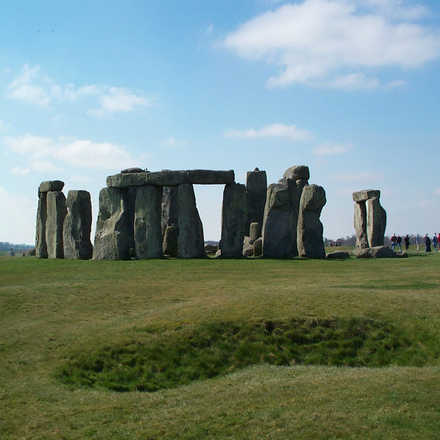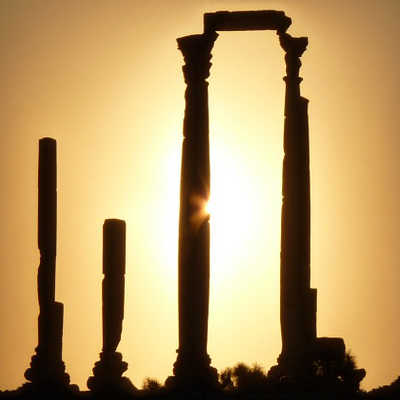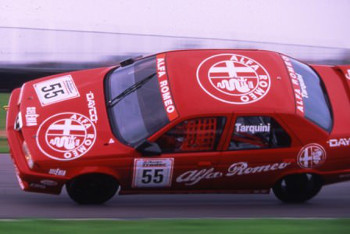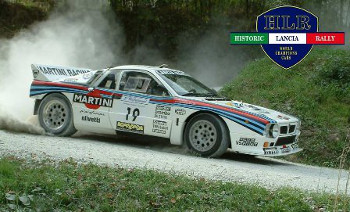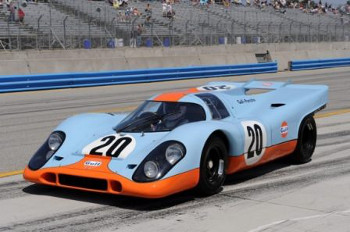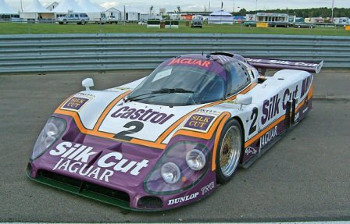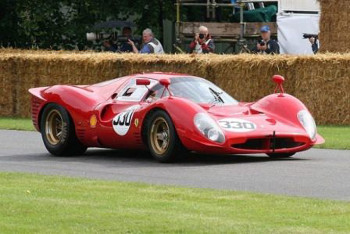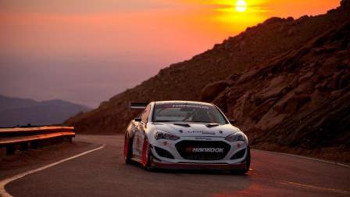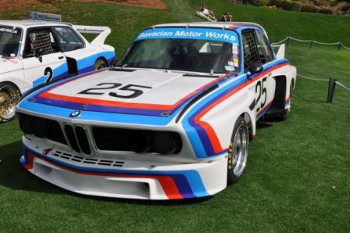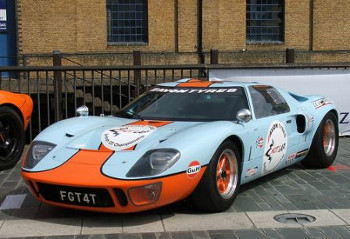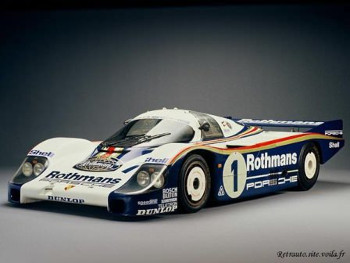My Top 10 Racing Cars Of All Time.
Written by Frazer McMenzie.
This week I thought I would share with you ten of my favourite racing cars of all time and, some of the reasons for these selections. I have based my choice on many factors, not just on outright success, because there are great cars and great drivers, but both don’t necessarily appear always in the same car. My only criteria were that all of them had to be cars for the track. However I have not included any Formula 1 or open wheel racing cars as there will be more lists to come. Please feel free to share your top 10 in the comments section below as I will be researching different cars and teams over the coming weeks and would love to hear your views.
So here they are - my ‘Top Ten’ - in reverse order.
Number 10
The Alfa Romeo 155, Alfa Course Factory works Team. 1994. The Alfa 155 driven by Gabriele Tarquini in the British Touring Car Championship in 1994 was one of the first car posters I had up on my wall as a 10 year old; Tarquini won the championship at the first attempt in an Alfa Romeo. No Italian manufacture has won the British Touring Car Championship since and I think the car still looks amazing to this day!
|
|
Number 9 The Lancia 037, Martini Racing. 1982-1986. Well to start with there is that Martini livery and the complete madness of the Group B rally cars that were outlawed by the F.I.A. Walter Röhrl and Markku Alén got first and second in the World Rally Championship in 1983. Sadly in Corsica, on the fourth stage of the rally, Attilio Bettega lost control of his Lancia and crashed into a tree which simply ruptured into the driver's seat and killed him instantly. This was the beginning of the end for Group B rally cars, Exactly one year later his former teammate Henri Toivonen and his co-pilot Sergio Cresto with the Lancia Delta S4 #4 (same number of the Bettega's car) died in a fireball accident at the same event, causing a ban for Group B. |
|
Number 8 The Porsche 917, Weyer-Gulf Team. 1969 -1973. The car that stared in the Steve McQueen movie Le Mans, with arguably one of the most famous liveries in all of motorsport. The car was capable of 0-62 mph (100 km/h) in a time of 2.3 seconds, 0–124 mph (200 km/h) in 5.3 seconds, and a top speed of over 240 mph in the 1970's!! Madness even by today's standards. In the 1973 Can-Am series, the turbocharged version Porsche 917/30 developed 1,100 BHP. It gave Porsche its first wins at the 24 Hours of Le Mans in 1970 and 1971. The 917 is one of the most iconic sports racing cars of all time. |
|
Number 7 The Jaguar XJR-9, Tom Walkinshaw Racing. 1988-1990. The XJR-9 was able to take victories, including the 24 Hours of Le Mans, WSCC championships winner over the eleven race season and clinch another world championship for Walkinshaw Racing. Jaguar's success at Le Mans marked the first time since 1980 that Porsche had not won Le Mans, and the first Le Mans victory for Jaguar since 1957.With its closed rear wheel design it has a certain cult following, It was powered by a Jaguar 7.0-litre V12 based 5.3-litre engine used in the Jaguar XJS road car with a low-drag aerodynamic package to achieve crazy top speeds.
|
|
Number 6 The Ferrari 330 P4, Ferrari Racing. 1967. One of the rarest racing cars you will find on this list. Only four Ferrari P4-engined cars were ever made: one P3/4 and three 330 P4s. The P3/4, one of the P4s, and one 412 P electrified the racing world when they crossed the finish line first, second and third in the 1967 24 Hours of Daytona. The 330 P4 has it all in book, it has the racing heritage, its rare, only one remains in its original state, and is owned by Lawrence Stroll. It’s fast, it looks like a 1960,s Batman and should just be painted black and taken for a spin.
|
|
Number 5 The Hyundai Genesis Pikes Peak, 2012. Rhys Millen Racing. O.k. so I expect people to now have a laugh as I have a Hyundai in my top 10 racing cars of all time. Well last year on the infamous Pikes Peak International Hill Climb this Hyundai Genesis set the world record time of 9:46.164. The track measures 12.42 miles (19.99 km) over 156 turns. It is the first car ever to break the 10-minute barrier to reach the 4300-metre summit of Pikes Peak. A Garrett GTX3582 turbocharger was fitted to the Hyundai V6 engine and when you add an amazing driver, it was a great set up. I strongly advise you watch the video on YouTube. |
|
Number 4 The BMW 3.0 CSL, BMW Racing, 1973-1979. In its seven active years on the European Touring Car Championship it won Six Championships only missing out in 1974. It has the racing calibre but the main reason it makes the list is well, it’s an amazing looking machine with the famous BMW motorsports livery. A true legend of 1970 Touring car racing that laid the path for further excellent BMW motorsport homologations. |
|
Number 3 The Ford GT40, Ford Racing, 1966 to 1969. With this car the story is nearly as compelling as the looks of the thing. The story goes, short version, that Ford wanted to buy Ferrari. Ferrari said no! Ferrari had won at Le Mans six times in a row from 1960 to 1965. Ford wanted the sports car market that Ferrari had so Ford decided if they couldn't buy them they would have to beat them and the GT40 was born. In 1966, with Henry Ford II in attendance himself in Le Mans, the MkII GT40 provided Ford with the first overall Le Mans victory for an American manufacturer. Ford won the 24 Hours of Le Mans four consecutive times, from 1966 to 1969 and never bought Ferrari. |
|
Number 2
The Mazda 787B, Mazdaspeed, 1990-1991 The first 787 chassis made its competition debut in April 1990. Former Le Mans-winner Jacky Ickx was hired by Mazdaspeed in order to prepare the two 787s. It was not that successful, winning only one of the twenty one races it was entered in during its brief life, so why is it on the list? Well I have added a YouTube and just listen to the sound of the thing and how it corners! Unreal! And the one race it did win, the 59th 24 Hours of Le Mans beating three Jaguar XJR-12 also on the list says it all. |
|
Number 1 The Porsche 956, Factory-run Rothmans-sponsored, 1982-1984 In total, twenty-eight 956s would be built by Porsche from 1982 to 1984. The 956 holds the all-time record for the fastest vehicle ever to lap the famed Nürburgring, completing the 13 mile circuit in 6 minutes and 11 seconds set by Stefan Bellof in 1983. The race lap record is held by the same Bellof, during the 1983 1000 km Nürburgring, the lap being clocked at 6:25, I doubt it will ever be beaten! Tragically Bellof was involved in an accident in a 956 during the 1985 1000 km of Spa where he died after colliding with Jacky Ickx's newer Porsche 962. Safety concerns over the 956 led to the eventual end as teams upgraded to the safer 962. |
|
{youtube}GA3nhl0nhMg|350|270|1{/youtube} |
Follow us on Twitter - @DigiPrintNews
Like us on Facebook www.facebook.com/dpnlive - click the ‘LIKED’ button/top of page as well
Copyright © 2013, DPNLIVE – All Rights Reserved
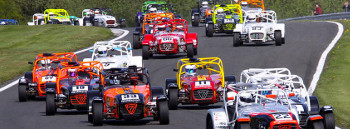 motorsportMotorsport is a huge topic and it covers so many aspects. So I will concentrate on the Motorsport that I personally like to watch. When you think about this sport it brings to mind a multitude of activities such as bike racing, rallying, sports car racing and Formula 1. The motorsports I like to watch are mainly Formula1, rallying, sports cars and some motorbike racing. So what is it that makes watching these four so enthralling? Well I suppose it is because an individual is pitting themselves against a difficult circuit while at the same time controlling a highly powerful machine in order to overcome not only the circuit, but control the device in order to ultimately beat the other contestants.
motorsportMotorsport is a huge topic and it covers so many aspects. So I will concentrate on the Motorsport that I personally like to watch. When you think about this sport it brings to mind a multitude of activities such as bike racing, rallying, sports car racing and Formula 1. The motorsports I like to watch are mainly Formula1, rallying, sports cars and some motorbike racing. So what is it that makes watching these four so enthralling? Well I suppose it is because an individual is pitting themselves against a difficult circuit while at the same time controlling a highly powerful machine in order to overcome not only the circuit, but control the device in order to ultimately beat the other contestants.
If we take rallying then what is it about it that makes it so interesting? In my view you have a car that has been slightly or extensively modified which the driver is trying to drive it from A to B in the quickest time over different stages designed to test car and driver to the absolute limit. In the world championships they do it on different surfaces testing the car and driver even more. To me it is very watchable because with modern technology there is a camera in the car and this allows you to view exactly what the driver and co-driver are seeing. This makes the experience very real and you can sometimes feel yourself taking the bends and jumps with them.
Rallying is not only a professional sport it is also an interest for many people who love to test themselves or have a craving for something dangerous. There is a number of Motor Clubs around which cater for these people, many of them driving modified standard road cars. You will often find that they have friends who are mechanics and they work together. I must admit that I enjoy watching the amateur side of rallying a lot because you know that they are everyday people with a job and to them it is a hobby (a pretty expensive hobby I might add). As a spectator spectacle either on television or in person it is magical to watch.
One of my own favourites is sports car racing. These can range from your humble Mazda MX5 right up to specially designed and built cars by motor manufacturers. There are owners clubs and clubs that run events and many of the drivers and teams are amateur as well as professional teams and many of them will have sponsors to help with the running costs. Sports Car Racing is great to watch on television especially on some of the classic circuits which they use. One day I would love to go and watch the Le Mans 24 Hours, to any sports car fan it is the pinnacle of this type of racing.
Sports car racing has numerous categories and sub divisions which I am not going to list. It does include a classic division which is for people who have bought a motor manufacturers car, now own it privately and still want to race it. Sometimes they may form a team and race it that way because by doing so it is somewhat less expensive as they end up looking for sponsorship to cover some or all of the costs. The motor manufacturer built cars are phenomenal pieces of machinery and often the new technology they use on them eventually filters down to the road cars and hopefully makes them safer.
Although I like some motor bike racing I do not watch a huge amount but when I do I am amazed at the control of the riders. When you think they are riding a very powerful machine and often have a tiny patch of rubber keeping them upright, that takes some doing. Yes you do see some spectacular falls but in most cases the rider gets up and walks away because of the safety element which today is so highly visible. Many of the major bike manufacturers enter either as a factory team or supply an independent team who get sponsorship running into millions of dollars. There are many levels and different engine sizes in motor bike racing and they all appear to be as exciting as each other but I tend mostly to watch the super bikes or Moto GP.
However my favourite motor sport is Formula 1 and over the last few years it has become very watchable. This is mainly due to the rule changes the governing body has introduced. These have worked well for the big teams but they have also worked well for the smaller teams and have closed the gap slightly. Yes I agree there are still four top teams and a growing number of middle teams and the number of minnows (as they are referred to) is getting smaller. Some of the technology being developed and used has also filtered down to our everyday cars and this can only be good for driver safety. The standard expertise of the current top drivers is to be honest very frightening because it is so high and several of them seem to absolutely fearless. I can recall several overtaking moves in the 2012 season. Some of these were almost death defying, or at least very risky and commentators could not believe that such moves were even being considered at that point on the track.
I do agree that it is a hugely expensive sport but I look at the drivers and they are risking their lives for something they love to do which makes it a fantastic spectator spectacle. I know they get paid very well but in my opinion they thoroughly deserve it. The companies involved have to raise huge amounts in sponsorship and I look at it as a highly visible form of promotion for the sponsors. Formula 1 is regarded by the vast majority of the racing drivers as the ultimate goal in their driving career, and so it should be. You are driving a high powered very light piece of machinery that can go from 0 to 100 in less than five seconds and who would not want to drive something like that?
My enjoyment and fascination for Formula 1 has been with me for many years. It began I think really in the sixties when it was much more dangerous. Today, even with the much improved safety requirements, it is still just as exciting and interesting to watch. With 20 races a year it has truly become a world championship. Yes I know we have had the same winner for the last three years but a large amount of that is down to the design team. This includes working with the engine supplier to get the car and engine to work as a single unit and the top four teams are doing that so well.
I look forward to the coming seasons with great anticipation and hope that we see some exciting races and maybe a couple of new world champions.
Adrian Rush MISTC
Managing Partner
AMR Enterprises
Mob : +353 (0)87 677 3631
E-mail: - This email address is being protected from spambots. You need JavaScript enabled to view it." mce_' + path + '\'' + prefix + ':' + addy92747 + '\'>'+addy_text92747+'<\/a>';
//-->
Follow us on Twitter - @DigiPrintNews
Like us on Facebook at www.facebook.com/dpnlive
Copyright © 2013, DPNLIVE – All Rights Reserved
B.M.W. Motorsport a Brief History
Written By Frazer McMenzie
(Bmw E30) Pictures By Daniel McMenzie
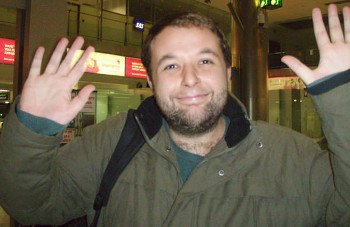 Frazer McMenzieBMW was established as a business manufacturing aircraft during World War One in 1917. At the end of the war it was forced to cease production of aircraft engines by the terms of the Versailles Armistice Treaty. The company consequently shifted to motorcycle production in 1923 and then moved into the production of Automobiles in 1928 as the Treaty lifted.
Frazer McMenzieBMW was established as a business manufacturing aircraft during World War One in 1917. At the end of the war it was forced to cease production of aircraft engines by the terms of the Versailles Armistice Treaty. The company consequently shifted to motorcycle production in 1923 and then moved into the production of Automobiles in 1928 as the Treaty lifted.
BMW M, also known as M-Technik or simply "M" for Motorsport was created to facilitate BMW’s racing program, which had a great deal of successful cars during the 1960s and 1970s.
The M badge cars story all began in May of 1972 with 35 employees specialising in producing M cars to sell to the public. By 1988 the program was so successful that the number of employees had risen to 400. The M badge on a BMW means that that specific model in the range may not look to dissimilar from a business or family car but under the skin is a true wolf in sheep's clothing. All M badge cars have traditionally included modified engines, transmissions, suspensions, interior trims, aerodynamics, and exterior modifications, however subtle to set them apart from their counterparts. Every M model is tested and tuned at BMW's private facility at the Nürburgring racing circuit in Germany.
The first official M-badge car for sale to the public was the M1, revealed at the Paris Motor Show in 1978. The M1, however, was more of a race car in domestic trim than an everyday driver. The direction of the M cars changed with the 1979 release of the M535i, which was a high performance version of BMW’s popular 5 Series saloon car.
Below is a list of the current BMW
M badge cars in production:
M3 - E90 Sedan, E92 Coupé, E93 Cabriolet (2008 to present)
M5 - F10 Saloon (2011 to present)
M6 - F12 Coupé, F13 Cabriolet (2012 to present)
X5 M - E70 SAV (2010 to present)
X6 M - E71 SAV (2010 to present)
Below is a table showing all previous models of M cars from 1978 until the end of their production run with a total of 17 different cars not to mention the 5 above models currently in production.
YEARS | MODEL | CAPACITY OF ENGINE | NUMBER OF CYLINDERS | POWER (PS) BHP | PRODUCTION TOTALS |
1978-1981 | M1 (E26) | 3.5 Litre | Inline 6 | 277 | 456 |
1979 | M535i (E12) | 3.5 Litre | Inline 6 | 219 | 1,862 |
1983-1989 | M635 CSi (E24) | 3.5 Litre | Inline 6 | 260-286 | 5,859 |
1985-1988 | M5 (E28) | 3.5 Litre | Inline 6 | 286 | 2,191 |
1986-1992 | M3 (E30) | 2.3 Litre | Inline 4 | 195 | 16,202 |
1988-1995 | M5 (E34) | 3.6 Litre or 3.8 Litre | Inline 6 | 315 or 340 | 32,587 |
1992-1999 | M3 (E36) | 3.0 Litre or 3.2 Litre | Inline 6 | 286 or 321 | 71,242 |
1998-2002 | M Roadster M Coupe (E36) | 3.2 Litre | Inline 6 | 321 | Coupe: 6,318 Roadster: 15,375 |
1998-2003 | M5 (E39) | 5.0 Litre | V8 | 400 | 20,482 |
2001-2006 | M3 (E46) | 3.2 Litre or 4.0 Litre | Inline 6 or V8 | 343 or 380 | 85,744 |
2005-2012 | M5 (E60 &E61) | 5.0 Litre | V10 | 507 | 20,547 |
2006-2008 | M6 (E63 &E64) | 5.0 Litre | V10 | 507 | 5,070 |
2006-2008 | Z4 M (E85 &86) | 3.2 Litre | Inline 6 | 343 | 9,355 |
2007 | M3 (E90/92/93) | 4.0 Litre | V8 | 420 | Not Available |
2009 | X5 M (E70) | 4.4 Litre | V8 | 555 | Not Available |
2009 | X6 M (E71) | 4.4 Litre | V8 | 555 | Not Available |
2011-2012 | 1M Coupe | 3.0 | Inline 6 | 335 | 750 (Limited) |
Since the origins of the M cars back in 1978 BMWs main rivals, Audi and Mercedes, were seeing the success of these cars coming out of Munich, and have been trying to compete with them ever since. Now don't get me wrong, I am sure that AMG Mercedes and Audis RS and S-line cars designed in skunk works with a very similar model of BMW M- Technik are great cars; but their problem is every time they release a new model it is immediately compared to the current BMW M3 or BMW M5. Mercedes have always gone down the high power road developing many big cars with brutally big engine producing unbelievable horsepower such as the 6.0L V12 Bi-Turbo in the SL65 AMG or the M156 6.2L V8 in the CL63 AMG. Audi on the other hand developed their S-Line and RS model from the platform of their Group B world rally championship success in the 1980s optimising acceleration using their Quattro for wheel drive systems to this day in current models such as the RS 4 and RS6.
In recent years BMW have more competitors than ever in the Motorsports market. Aside from Mercedes and Audi, Lexus have recently entered the equation with the IS-F along with many independent companies offering their own performance versions of BMW models. Such companies include Hamann Motorsport, Alpina, Dinan Cars, AC Schnitzer and Hartge. The fastest and most powerful BMW M conversions are made by German tuner G-Power; it holds several world speed records including the M5 Hurricane RR with 372.1 km/h (231.3 mph).
BMW M cars have always been held in high esteem for the most part by the motoring press and car enthusiasts alike. This is for several reasons, not least because they are first and foremost unquestionably brilliantly engineered and designed cars.
Another great selling point is the fact that not only can they be used on the road for day to day tasks such as the school run or shopping, but you can then take them to a track and mix it with supercars that you could never take to the supermarket or get over a speed bump in. It is the ultimate compromise of practicality and performance. All the new M badge cars have computers that can change the car set up in so many ways like adjusting the throttle response, power from the engine, ferocity of the gear changes and the list goes on. So you can have a calm well mannered family saloon one day then take it to a track, change a few settings, press the M button and scare yourself silly.
One of the great things about an M car is the styling. Admittedly any self respecting car or BMW enthusiast can spot an M car a mile off, or for that matter some IDIOT who has stuck an M badge on a BMW 316!! To the man in the street an M3 or an M5 just looks like a normal saloon car or compact. If you drove round in a bright red Ferrari or a Lamborghini in Sunburst Yellow you would be laughed at, ridiculed, despised by fellow motorists because your car cost more than their house subsequently never getting let out of a junction. That is why the BMW M series cars are a far more discreet option for those who wish to remain unnoticed by the masses but noticed by the connoisseurs.
Now I know people would say some M cars are a bit too technology orientated and the price is not that far off a two year old Ferrari, Lamborghini or even a new Porsche, however I would go with the M badge every time.
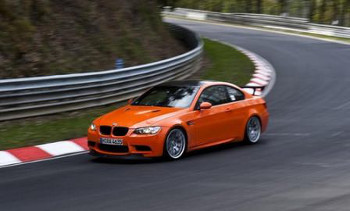 BMW M3 GTS 2 BMW M3 GTS 2 | 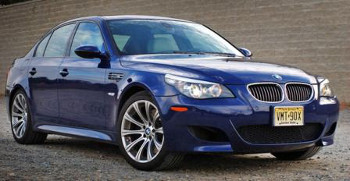 BMW M5 4 BMW M5 4 |
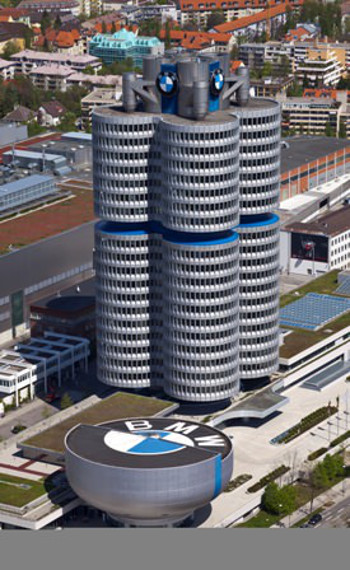 BMW Munich BMW Munich |
Copyright © 2012, DPNLIVE – All Rights Reserved
Ford Motorsport: A Brief History
Written by Frazer McMenzie
Pictures by Daniel McMenzie
 RSAC Dumfries 1In the 1950’s two men called Harley Earl and Bill France Sr. coined the phrase "Race on Sunday, Sell on Monday." Over the past 40 years Ford have built part of their business model on this in the U.K.
RSAC Dumfries 1In the 1950’s two men called Harley Earl and Bill France Sr. coined the phrase "Race on Sunday, Sell on Monday." Over the past 40 years Ford have built part of their business model on this in the U.K.
Mr. Earl and Mr. France came up with the notion that a car that is successful on a racetrack would translate into successful sales in the showroom. Ironically the aforementioned Gentlemen did not work for Ford; they worked for Pontiac, a division of General Motors the arch rival of Ford in the U.S.A. and worldwide to this day!
It was all about selling the dream, the romance, the pedigree and most importantly the bragging rights in the local pub. This is where Ford got things right, investing heavily in various motorsports for a long period of time which cost millions but they understood that selling the road going versions of the cars at an attainable price and there is some serious money to be made.
I will Focus, (pardon the pun) on Ford’s endeavours in European Motorsports as NASCAR just isn't really my cup of Tea! The main three areas of investment for Ford motorsport since they began development of their motorsports program were; Formula 1, World Rally Championship and Touring cars.
The Ford Motorsports division have some impressive accolades with numerous wins in varied disciplines:
SERIES | RACE WINS | MANUFACTURERS TITLES | DRIVERS TITLES |
Formula 1 | 176 | 10 | 13 |
NASCAR | 606 | 16 | 7 |
World Rally | 75 | 3 | 2 |
Touring Car | 175 | 14 | 23 |
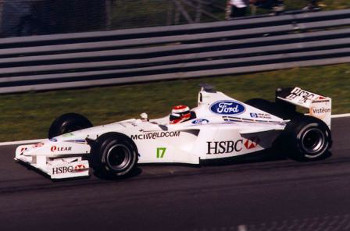 Johnny Herbert 1999 CanadaBelow I have listed what I believe to be three major milestones for Ford Motorsport:
Johnny Herbert 1999 CanadaBelow I have listed what I believe to be three major milestones for Ford Motorsport:
1967 - Jim Clark, driving a Lotus-Ford, won the Dutch Grand Prix. This is Ford's first grand prix victory.
2003 - Giancarlo Fisichella, driving a Jordan-Ford, won the Brazilian Grand Prix. This is Ford's 176th and last grand prix victory.
2011 - Trevor Bayne wins the 2011 Daytona 500 in a 1-2-3 finish for Ford. It would be Ford's 600th NASCAR victory.
With Ford seeing success on the track the road going versions of the World Rally cars and the Touring Car Championship were ready for production. In the U.S.A. there was the Ford Performance Vehicles, Special Vehicle Team (SVT), North America's performance car division. In Europe our road going racers were given the RS and ST, Ford Team RS European performance car divisions (Ford's ST and RS.) The most iconic of the badges were the RS models. The Ford RS badge was born for rally racing, the RS stands for Rally Sport. Below I have listed the RS range a true Ford fans ultimate garage:
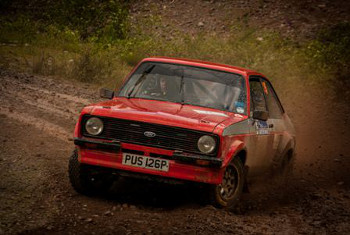 RSAC Dumfries1970 - Ford Escort RS1600, Ford Capri RS2600
RSAC Dumfries1970 - Ford Escort RS1600, Ford Capri RS2600
1973 - Ford Escort RS2000, Ford Capri RS3100
1975 - Ford Escort RS1800
1976 - Ford Escort RS Mexico, Ford Escort RS2000 Mk II
1981 - Ford Escort RS1600i
1984 - Ford Escort RS Turbo, Ford RS200
1985 - Ford Sierra RS Cosworth
1987 - Ford Sierra RS500 Cosworth
1988 - Ford Sierra Cosworth
1990 - Ford Sierra Cosworth 4x4. Ford Fiesta RS Turbo
1991 - Ford Escort RS2000
1992 - Ford Escort RS Cosworth, Ford Fiesta RS1800
1994 - Ford Escort RS2000 4x4
2002 - Ford Focus RS
2009 - Ford Focus RS Mk II
2010 - Ford Focus RS500 Ford ST models
1997 - Ford Mondeo ST24
2000 - Ford Mondeo ST200
2002 - Ford Focus ST170, Ford Mondeo ST220
2004 - Ford Fiesta ST
2005 - Ford Focus ST
The RS range of fast fords has been the most successful in capturing the imagination of the public. All of the RS range was developed for Rallies testing man and machine, durability and speed to the upmost in locations all over the world in all kinds of conditions.
Ford had a long and successful history in rallying, winning the World Rally Championship (WRC) in 1979 with the Ford Escort RS1800 and drivers Hannu Mikkola, Björn Waldegård and Ari Vatanen. In 1986 the Group B Ford RS200 made its debut, but by the end of the year Group B was banned. From 1987 Ford Motorsport entered the Ford Sierra. The Ford Escort RS Cosworth was introduced in 1993 and won rallies until 1996. For 1995, Ford handed over the running of its programme to RAS Sport of Belgium. At the end of 1996, Ford of Europe and its motorsports arm selected Malcolm Wilson and his M-Sport company to run the cars in the WRC from 1997 onwards.
Formula One is the biggest stage in the world for Driver and manufacturer alike. The team's origins are traced back to 1988 when Jackie Stewart's son Paul set up Paul Stewart Racing at the end of 1988 when he bought the Gary Evans Motorsport Team. His team entered the 1989 British Formula 3 season with a workforce of 10 employees. The team attracted the sponsor Camel. Paul Stewart had driven the car alongside German Otto Rensring. The team's first season had not been hugely successful with a sole win for Stewart at Snetterton. In 1990, the team expanded with a move to their headquarters in Milton Keynes and was divided into three sections; preparation for European Formula 3000, Formula 3 and Formula Vauxhall Lotus. Within a few years, the team enjoyed huge success in Motor Racing by winning 12 titles and 119 races in various categories. Jackie Stewart secured a five-year development deal with Ford to make it a factory team. Ford had been in a deal as a factory engine supplier to Sauber before this.
After Ford acquired Cosworth in July 1998, they risked designing and building a brand-new engine for 1999. The SF3 was quick out of the box, however for Ford both cars over-heated on the grid of the first race, the Australian Grand Prix, after qualifying competitively. This put Herbert out instantly and made Barrichello start from the pit lane. Barrichello received a stop-go penalty during the race and finished 5th. The car was consistently competitive throughout the season; however the engine initially proved fragile as both cars blew their engines at the Brazilian race which meant the engine was rarely run at full power. Stewart's competitiveness was affirmed by running first in Brazil for a long spell of the race and qualifying on pole for the French Grand Prix with Barrichello. Johnny Herbert won a popular victory at the rain soaked 1999 European Grand Prix at the new Nürburgring after other leading contenders crashed off the track or lost time in the pits changing tyres. After Ford increased its commitment by buying the team out, it became known as Jaguar Racing for the 2000 season. Poor results however, led to the team being sold for the 2005 season, becoming Red Bull Racing.
Ford have had the success on the track and this has translated into showroom sales being the most popular car on the U.K. roads and winning car of the year in many European countries. In the ever changing car consumer market the emphasis has now shifted to the eco consumer and the fuel economy weary customer. But I say if you want Ferrari thrills without the bills you can never go wrong with a fast Ford!
Copyright © 2012, DPNLIVE – All Rights Reserved
26 Years of the Hungaroring
By Frazer McMenzie
 Frazer McMenzie
Frazer McMenzie
 HungaroringAfter watching the conclusion to the Hungaroring, Hungarian Grand Prix 2012 I thought back to the last time I attended the same Grand Prix event seven years ago. I can also remember watching it back in the 1990’s on TV and thinking, I wonder how long has it been a host to Formula One? After all, it is one of those venues that seems never to steal the headlines, but is a fantastic event, with a knowledgeable crowd. It may not have the history of Silverstone, Circuit de Spa-Francorchamps or the romance and glamour of Circuit de Monaco, all of which have been used as Grand Prix venues since 1950.
HungaroringAfter watching the conclusion to the Hungaroring, Hungarian Grand Prix 2012 I thought back to the last time I attended the same Grand Prix event seven years ago. I can also remember watching it back in the 1990’s on TV and thinking, I wonder how long has it been a host to Formula One? After all, it is one of those venues that seems never to steal the headlines, but is a fantastic event, with a knowledgeable crowd. It may not have the history of Silverstone, Circuit de Spa-Francorchamps or the romance and glamour of Circuit de Monaco, all of which have been used as Grand Prix venues since 1950.
On the 1st of October 1985 construction began on what is now the oldest purpose built Formula One track on the calendar. Its inclusion in the 1986 Formula One season was to become the first Formula One event held behind the Iron Curtain. Legend has it that Bernie Ecclestone was pushing for a race venue in the U.S.S.R. But a Hungarian friend of Mr. Ecclestone had a suggestion, Budapest.
The original concept was to hold a street circuit event to emulate a Circuit de Monaco experience in the Népliget -the largest park area of the City. However the government chose to build a purpose built circuit just outside the city to the North East in Mogyoród. This decision may have been an inspired one. With the modern era of Formula One demanding the highest safety, the best accessibility along with the massive logistical demands of the sport, if Hungary did not have a purpose built Formula One track we could have lost a Hungarian Grand Prix many years ago.
 HungaroringThe Hungaroring itself is a test of driver and spectator endurance alike. It’s built into a very dry, hot valley, 16 turns over 4.3 kilometres, and a monster start/ finish straight with the added bonus of the 30 degree plus heat of July. The rural setting for the track creates an arid dust bowl due to its under use throughout the year with zero wind other than that of Formula one cars flying around the circuit when the F1 circus comes to town.
HungaroringThe Hungaroring itself is a test of driver and spectator endurance alike. It’s built into a very dry, hot valley, 16 turns over 4.3 kilometres, and a monster start/ finish straight with the added bonus of the 30 degree plus heat of July. The rural setting for the track creates an arid dust bowl due to its under use throughout the year with zero wind other than that of Formula one cars flying around the circuit when the F1 circus comes to town.
Nowadays in the politically charged world of Formula one the Circus visits more and more new locations all over the globe. The cynic will say there goes Mr Ecclestone chasing the money round the world, staying well clear of recession saddled Europe and the cynics may have a point. New tracks have popped up all over the world in many affluent or emerging countries. Malaysia, China, Singapore, Korea and India are all relatively new additions as Formula One heads east. My only concern is that because of the Formula one policy of chasing money around the globe, more traditional tracks in Europe have and will continue to be cut from the Formula One calendar.
We lost the Belgian Grand Prix at Spa for two years and nearly did not have a British Grand Prix at all recently. Circuit de Magny-Cours the French Grand prix went the way of the dinosaurs in 2008, there has not been an Austrian Grand Prix since 2003 or a Dutch Grand Prix since 1985. I hope that the Hungaroring will not suffer a similar fate as Formula One now looks to expand its reach into the U.S. further, similar to the strategy adopted in the east. It is understandable that Formula one is now a global sport with a huge T.V. audience but losing more European tracks the likes of the Hungaroring that is well attended and the historic birthplace of the sport would be a tragedy.
Previous Winners of the Hungarian Grand Prix
Date Winner Team
2012 Lewis Hamilton McLaren
2011 Jenson Button McLaren
2010 Mark Webber Red Bull-Renault
2009 Lewis Hamilton McLaren
2008 Heikki Kovalainen McLaren
2007 Lewis Hamilton McLaren
2006 Jenson Button Honda
2005 Kimi Räikkönen McLaren
2004 Michael Schumacher Ferrari
2003 Fernando Alonso Renault
2002 Rubens Barrichello Ferrari
2001 Michael Schumacher Ferrari
2000 Mika Hakkinen McLaren
1999 Mika Hakkinen McLaren
1998 Michael Schumacher Ferrari
1997 Jacques Villeneuve Williams
1996 Jacques Villeneuve Williams
1995 Damon Hill Williams
1994 Michael Schumacher Benetton
1993 Damon Hill Williams
1992 Ayrton Senna McLaren
1991 Ayrton Senna McLaren
1990 Thierry Boutsen Williams
1989 Nigel Mansell Ferrari
1988 Ayrton Senna McLaren
1987 Nelson Piquet Williams
1986 Nelson Piquet Williams
Copyright © 2012, DPNLIVE – All Rights Reserved
RSAC Scottish Rally 2012
Written by Frazer McMenzie
Photos by Daniel McMenzie
August 2012
After an entertaining rally in the Scottish Borders earlier in the month at Duns for the Jim Clark Memorial Rally, my brother and I decided to head back up to Dumfries in the Borders for the RSAC Scottish National Rally on the 30th June in search of more rally lunacy. We were not disappointed.
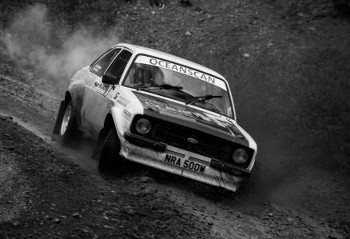 Rally CarGetting an early start to the day, we left Newcastle and headed to Heath Hall just north-east of Dumfries town. That was after a quick diversion to the Ice Bowl near Palmerston Park, the Queen of the South football ground, to pick up our rally program. With our map reader in the back of the car, it turned out to be a bit of a rally in itself!
Rally CarGetting an early start to the day, we left Newcastle and headed to Heath Hall just north-east of Dumfries town. That was after a quick diversion to the Ice Bowl near Palmerston Park, the Queen of the South football ground, to pick up our rally program. With our map reader in the back of the car, it turned out to be a bit of a rally in itself!
On arriving in Heath Hall, programs in hand, the rally park was nearing full swing, ahead of a day of six varied and challenging stages. Of the many car classes entered in the rally, we were especially on the lookout for the Class 12 4WD 2.0 plus monsters and the beautiful Class 8 RWD cars up to 2.0 with more than 8 valves. All of the class 8 cars were Ford Escort Mk2s, though we might be a bit biased as we love all things old and Ford.
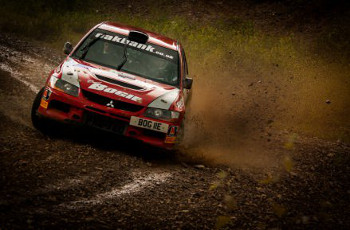 rally CarWe decided to leave the rally park in Heath Hall and head north to the Forest of Ae to watch the Ae West stage. As we arrived, the weather took a turn for the worse with a heavy downpour. The gravel forest track, steep banks and deep grooves carved in the racing line by car after car proved for some spectacular moments. The drivers demonstrated immense concentration and car control in tricky conditions. The conditions improved towards the end of the Ae West stage. The sun shone through the thick forest cover as the last of the Class 12 cars flew past spitting out rocks and deafening exhaust notes.
rally CarWe decided to leave the rally park in Heath Hall and head north to the Forest of Ae to watch the Ae West stage. As we arrived, the weather took a turn for the worse with a heavy downpour. The gravel forest track, steep banks and deep grooves carved in the racing line by car after car proved for some spectacular moments. The drivers demonstrated immense concentration and car control in tricky conditions. The conditions improved towards the end of the Ae West stage. The sun shone through the thick forest cover as the last of the Class 12 cars flew past spitting out rocks and deafening exhaust notes.
After a very entertaining and somewhat wet morning stage, we headed back down to Heath Hall in the afternoon for the super special stage SS5. This was first used back in 2004, a purpose-built spectator-friendly stage with a very entertaining water splash immediately followed by a gravel and rock-strewn hairpin. The RWD cars proved a big hit slowing through the water splash, power sliding round the hairpin and accelerating off up the hill.
The last vehicles to run were the Class 12 4WD cars and the Land Rovers. Due to their weight, the organisers run the heavy classes last because they tear up the gravel for the lighter and smaller classes of vehicle. This special stage proved to be a hit, very well attended by both the locals and anoraks like us.
The rally terrain and conditions took its toll, seeing four retirements in the historic rally classification and a further 24 retirements in the final official classification. A total of 65 teams finished with ten winners in their respective classes.
Congratulations to all the drivers for putting on a great show on the day and to all the marshals and organisers who make the event possible.
CLASS | OVERALL POSITION | DRIVER/CO-DRIVER CLASS WINNER | VEHICLE | TOTAL TIME |
CLASS 2 - 2WD CARS UP TO 1400CC | 48th | GARY SMITH MARK ROBERTS | VOLKSWAGEN POLO | 53:39.5 |
CLASS 3 - 2WD CARS UP TO 1600CC WITH 8 VALVES | 32nd | IAIN HAINING MAIRI RIDDICK | VAUXHALL NOVA | 49:07.6 |
CLASS 4 - 2WD CARS UP TO 1600CC WITH MORE THAN 8 VALVES | 21st | JOHN BOYD CHRIS WILLIAMSON | FORD FIESTA R2 | 47:26.6 |
CLASS 5 - 2WD CARS UP TO 2000CC WITH UP TO 8 VALVES | 45th | ROBERT PATERSON NEIL RICHARDSON | FORD ESCORT MK2 | 53:04.5 |
CLASS 7 - FWD CARS UP TO 2000CC WITH MORE THAN 8 VALVES | 29th | CRAIG RUTHERFORD ROSS HYND | HONDA CIVIC | 48:47.7 |
CLASS 8 - RWD CARS UP TO 2000CC WITH MORE THAN 8 VALVES | 16th | DAVID WILSON DAVE ROBSON | FORD ESCORT MK2 | 46:30.8 |
CLASS 10 - GROUP N 4WD CARS OVER 2000CC | 9th | DOUGAL BROWN LEWIS ROCHFORD | MITSUBISHI LANCER EVO 9 | 45:29.5 |
CLASS 12 - OTHER 4WD CARS OVER 2000CC | 1st | DAVID BOGIE KEVIN RAE | MITSUBISHI LANCER EVO 9 | 42:07.0 |
CLASS H2 - HISTORIC CATEGORY 2 RALLY CARS | 1st (H2) | PAUL MAY DANIEL MAY | FORD ESCORT MK1 MEXICO | 52:18.5 |
CLASS H3 - HISTORIC CATEGORY 3 RALLY CARS | 1st (H3) | STEVE BANNISTER LOUISE SUTHERLAND | FORD ESCORT MK2 | 45:16.2 |
http://www.flickr.com/photos/mcmenziephotography/sets/72157630623072900/
http://www.youtube.com/watch?v=RxhTHYu44nA&feature=plcp
Skerries - Baked in Sunshine
and a Great Day's Racing
By Bob Tallent
It’s Friday 6th July 2012. Martin did me a favour and got all the articles to me for uploading early for DPNlive. I started them at 2.00pm and finished them early at 8.30pm, all except for the music – (this week it was ABBA) – and the artisan – (Sarah Gough, Mileeven Bees) articles. These I put up on Sunday and Monday. I was going to Skerries for the weekend, to stay with Tommy & Annette Farrell for the annual Skerries 100 motorbike races. Every year I go there with my wife Loreto, who is from Skerries. You can read about the 2015 racing here, including the tragic death of Dr John Hinds.
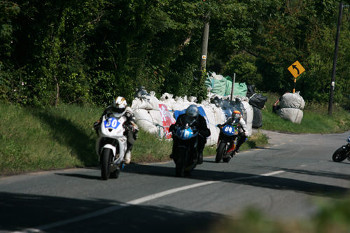 Skerries_100_2012The Skerries 100 Open Road Race circuit is presently 2.92 miles long. It used to be 7.1 miles long and went through the main streets of the town when it started on 6th July 1946. The winner then was 26 year old Harry Turner who rode a 348cc Norton over 14 laps. The day’s activities ended with a very well attended dance in the Tower Ballroom. It was the start of a success story that continues to the present day.
Skerries_100_2012The Skerries 100 Open Road Race circuit is presently 2.92 miles long. It used to be 7.1 miles long and went through the main streets of the town when it started on 6th July 1946. The winner then was 26 year old Harry Turner who rode a 348cc Norton over 14 laps. The day’s activities ended with a very well attended dance in the Tower Ballroom. It was the start of a success story that continues to the present day.
You see Tommy is a motorbike racing enthusiast and co-incidentally, he happens to live on the course. We were invited down for the weekend and arrived at 9.30pm, just in time to miss the practice session in pouring rain. It was restricted practice because of the conditions, but it was still necessary in order to arrange the placings for the main races the following day.
After a while we went out for a few pints to Joe Mays pub on the harbour. It’s the most beautiful setting you can imagine and you wouldn’t get better even on the Costa del Sol. The only difference, it was pouring rain. Normally on race nights the harbour and town are buzzing with excitement with fabulous motorbikes everywhere. It’s like an extravaganza of motorbikes that you just have to stop and look at some of them. This year – nothing! It’s been pouring rain all week, even Friday, and Saturday is due to be no different, or so the weatherman says.
Saturday morning comes and I’m woken at 9.00am by motorbikes screaming around the closed roads. I got up. Annette made me a big fry-up brekkie and I got my cameras ready. I went out around 10.30 to the driest day with brilliant sunshine. It was so sunny; I had to put on some P20 and a hat.
The racing started at 10.37 with the Classic 250-350cc Championship race. It was a relatively slow race with a top average lap speed of only 86.292 mph and was won by Keith Costello.
The Open Championship – 201-1000cc - race started at 11.14. This was much faster with an average best lap speed of 106.128 mph and was won by William Dunlop with his brother Michael only six seconds behind him at an average speed of 105.936 mph.
I was getting some great photos.
At 11.46 the Senior Support Irish Championship race – 401-750cc – started. Alan Kenny won it at a speed of 97.475mph.
After that I walked back up the course about a half a kilometre and found a good spot for the Junior 250cc Championship Race that started at 12.24. William Dunlop won this again at a speed of 99.846mph. More great photos.
After that I made my way back to Tommy’s house because the memory card on my camera was full and I wanted to get another one. Besides, it was lunch time. Tommy’s son John made some sandwiches. The garden was filling up and people were drinking beer.
 Skerries 100 race circuitAt 12.59, the 600cc Championship Race started. Now these guys were fast. William Dunlop must have had a bad start because in one lap he moved from seventh to third place. Then catastrophe! Just where I was standing at the last race, William came off his bike at about 130 mph. It’s said that he got a blowout. He was going so fast that his bike travelled on for about another 400 metres. People said that he broke his arm. The race was stopped. Ryan Farquhar won it at an average speed of 105.313 mph.
Skerries 100 race circuitAt 12.59, the 600cc Championship Race started. Now these guys were fast. William Dunlop must have had a bad start because in one lap he moved from seventh to third place. Then catastrophe! Just where I was standing at the last race, William came off his bike at about 130 mph. It’s said that he got a blowout. He was going so fast that his bike travelled on for about another 400 metres. People said that he broke his arm. The race was stopped. Ryan Farquhar won it at an average speed of 105.313 mph.
If you look at the map on your left, just click it to enlarge it, Tommy’s house is on the hairpin between Gillies Leap and the Shady Lane. It’s a first gear corner where the bikes practically come to a stop from travelling at around 200kph in a matter of seconds. That’s about 130mph. Then they take off again like a bat out of hell and hit about 150 mph. Tommy put his own ‘grandstand’ on his side of Shady Lane. Actually, it was a few planks of timber on a few crates. But it did the job. Tommy’s grandstand is about 100 metres up from the hairpin and I got brilliant photos of the bikes coming out of the corner, many of them doing wheelies.
I commented that many of my photos show bikes with their front wheels off the ground and Tommy told me that at the Isle of Man TT circuit, which is 37 miles long, it was calculated that the front wheels are off the ground for three miles. I suppose it’s one way of saving your tyres!!
2.31, the 125cc – Moto 450 Championship Race started. Ryan Farquhar won again at a speed of 94.093 mph.
The Classic 500-1000cc Championship Race started at 2.56. Ed Manly jnr won at a speed of 87.018 mph.
At 3.33 the 650cc Supertwins Race started. Another fast race won by Ryan Farquhar again at a speed of 105.313 mph.
At 4.03 the 201-400cc Championship Race started. Peter O’Flaherty won at a speed of 92.349 mph.
Next is the Grand Final at 4.48. Now these guys were really fast. Ryan Farquhar won again – his fourth win – at a speed of 108.729 mph. Ryan stole a dramatic final lap lead from Michael Dunlop to deny the Ballymoney man, who had been ahead for almost the entire race with John Burrows finishing third.
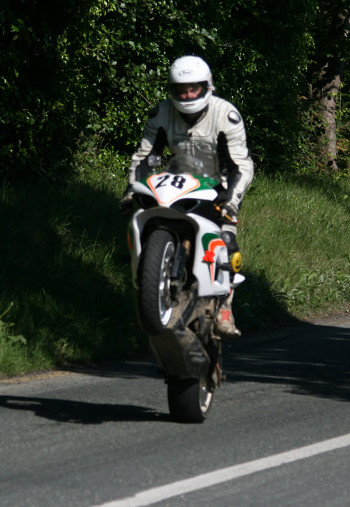 Skerries 100 2012. Paul Gartland doing a wheelie for the cameraSome of the racers must have seen me taking photos at Tommy’s grandstand on the Shady Lane because when a race ended I would give them a wave with my left hand and take a photo with my right and some of them would acknowledge by doing some great wheelies.
Skerries 100 2012. Paul Gartland doing a wheelie for the cameraSome of the racers must have seen me taking photos at Tommy’s grandstand on the Shady Lane because when a race ended I would give them a wave with my left hand and take a photo with my right and some of them would acknowledge by doing some great wheelies.
The final ‘race’ of the day wasn’t actually a race; it was a sort of display, where sidecars did three laps of the track. It was amazing watching these guys. They couldn’t race anyway because the roads were too narrow to allow them to overtake.
It transpired that William Dunlop didn’t break his arm. He dislocated his collarbone and will miss this week's Southern 100 races on the Isle of Man, and is also set to sit it out the Armoy races at the end of the month.
"There are no fractures but I have dislocated a collarbone and have a lot of bruising. I don't have a lot of movement in the arm and I'll be lucky to make it back for the Ulster Grand Prix," added the 26-year-old William.
It was a great days racing. Better still it was dry and sunny. Bernie Mackle and his son, Adam, who came over from England on his Ducati ST4 for the races got sun burnt. At least they can prove to their friends that it was sunny in Skerries when it was pouring in England.
I got over 300 great photos and then I was on BBQ duty for the next few hours. Burgers, chicken, pork and loads of salads that Annette and Loreto made. Add in a few pints, great banter and music. It was like being on your holidays and it was warm enough that we didn’t move indoors until around 9.30. I got to bed around 1.00am. A great day, great weather, good photos, great food, drink and friends and nobody badly injured, I can’t wait for next year.
Here's an onbike video of last years Skerries 100
This is the Junior Support race. Wayne Hall was racing a Honda RVF 400.
The hairpin I was at is at 2.01 on the video
New York’s Yankee Stadium, home to the New York Yankees baseball team is about to open its doors to soccer for the first time in a pre-season exhibition match between English Premier league club Chelsea and top French side Paris Saint-Germain (PSG) on July 22nd.
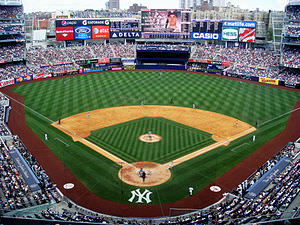 Yankee_StadiumThe stadium will be configured for 54,000 spectators in what will be Chelsea's first match in New York since 1954.
Yankee_StadiumThe stadium will be configured for 54,000 spectators in what will be Chelsea's first match in New York since 1954.
Chelsea chief executive Ron Gourlay said in a statement: "Chelsea Football Club is delighted to be heading to New York after such a long time away, and it will be a real pleasure to visit Yankee Stadium for what is sure to be a competitive game."
Chelsea’s visit to Yankee Stadium will be the team’s second in a four-city US tour which begins on July 18th against the Seattle Sounders at CenturyLink Field.
Soccer supporters in the States should enjoy this encounter since both teams are among Europe's elite; Chelsea is playing Bayern Munich on May 19th in the UEFA Champions League final, while PSG is three points behind Montpellier HSC for the top spot in France's premier Ligue 1.
The encounter at Yankee Stadium will also see former Chelsea and current PSG manager Carlo Ancelotti pitted against his old team for the first time since being fired last May. Although Ancelotti had success with Chelsea by leading them to a Premier League title in 2010, he was let go after a poor 2010-11 season.
Gourlay added that PSG would represent a serious test for Chelsea as the team prepared for the new season.
“It should be a fantastic game," he said.
Copyright © 2012, DPNLIVE – All Rights Reserved
Developments within the board of Xerox
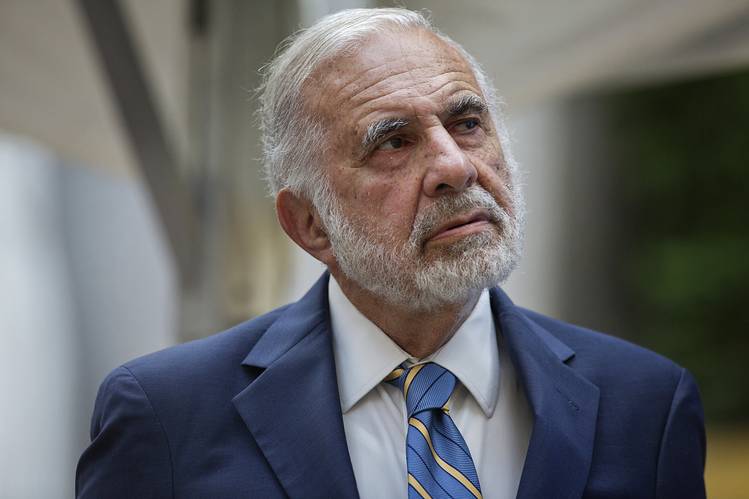 Billionaire activist investor Carl Icahn gained a seat on Xerox board. PHOTO: VICTOR J. BLUE/BLOOMBERG NEWSHere in DPNlive, we have recently reported to you about Xerox
Billionaire activist investor Carl Icahn gained a seat on Xerox board. PHOTO: VICTOR J. BLUE/BLOOMBERG NEWSHere in DPNlive, we have recently reported to you about Xerox
Xerox is splitting their company in two
Xerox splitting its company in two follow on report




